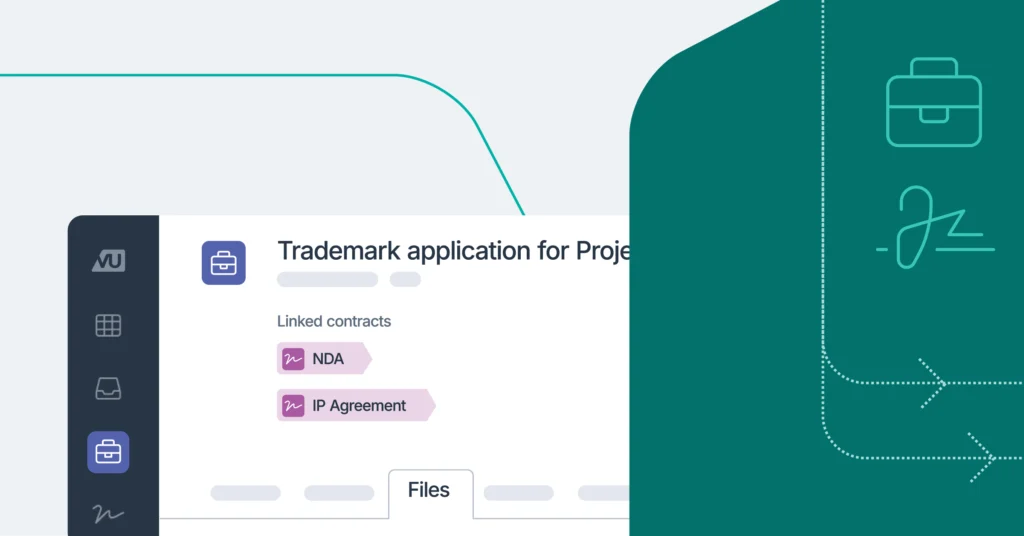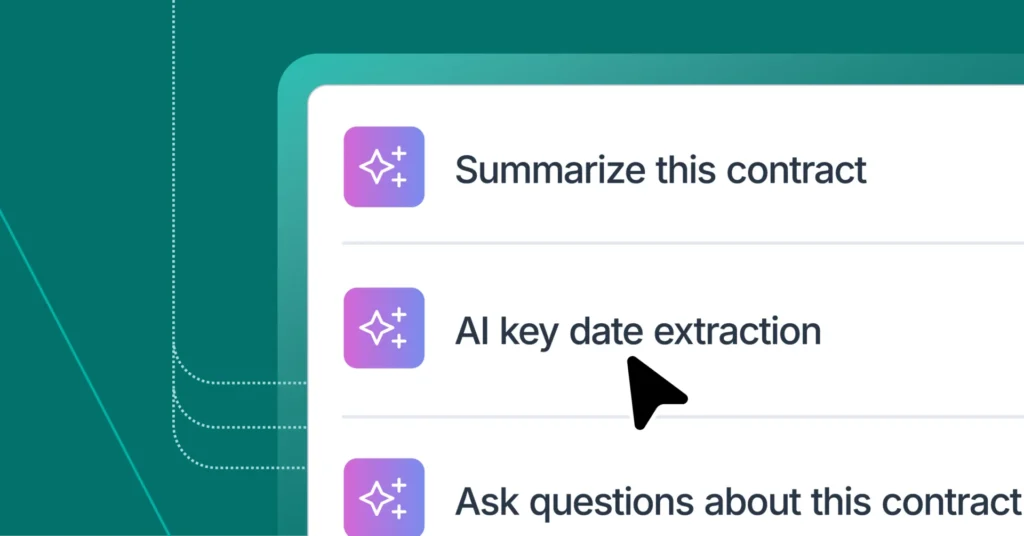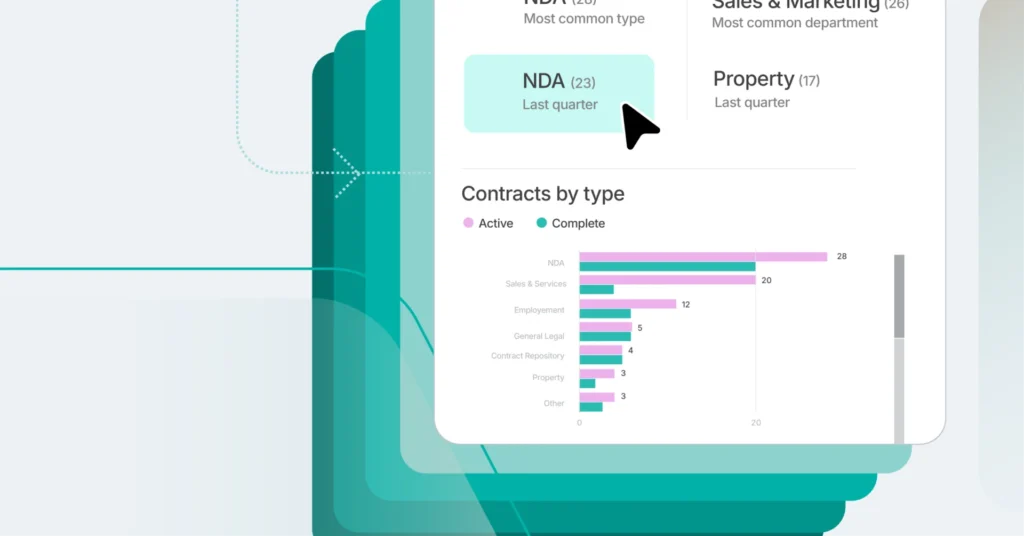6 ways contract workflow automation (with AI) can transform your CLM in 2025
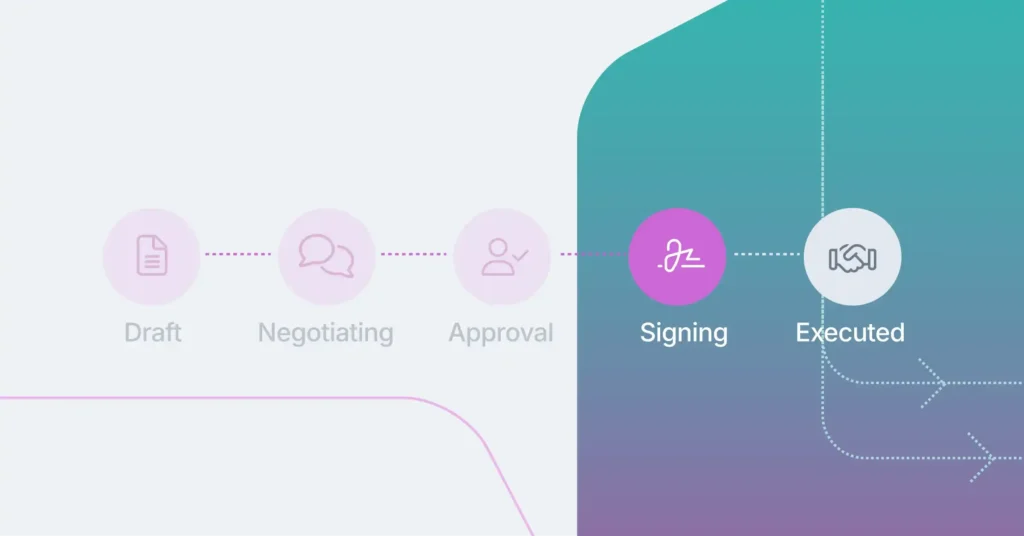
Contracts shouldn’t be a bottleneck, but for many legal teams they are quietly draining business performance, with recent IDC research revealing that on average, business leaders estimate that 11 percent of revenue is being lost or delayed every year as a result of legal inefficiencies. For businesses with a mean revenue of over USD $1 billion per year, this amounts to a loss of USD $141 million in annual revenue. This is where Contract Lifecycle Management (CLM) comes into play.
When done right, CLM can streamline legal workflows, reduce risk, and unlock new value for the business. But today’s in-house teams need more than visibility – they need scale. As workloads rise and expectations grow, automation is no longer just a “nice-to-have”. It’s mission critical.
Enter AI-powered contract workflow automation: the next evolution in CLM. By automating repetitive, time-consuming tasks and surfacing insights faster, legal teams can accelerate contract cycles, improve compliance, and reclaim time for strategic work.
In this article, we break down how AI-enhanced automation is reshaping contract workflows and what you need to consider to successfully implement it across both your legal function and the wider business. But if you need to hit pause to rewind and cover off the basics of CLM, this is a great place to start!
What is contract workflow automation?
Contract workflow automation in CLM refers to the use of software, often powered by AI, to streamline and automate repetitive, rule-based tasks throughout the contract lifecycle. Instead of relying on manual handoffs, email chains or spreadsheets, legal teams can use contract workflow automations to keep contracts moving efficiently from creation to execution and renewal.
Common use cases of contract workflow automation in CLM include:
- Approvals: Automatically routing contracts to the right stakeholders based on predefined rules (e.g. value thresholds or contract type).
- Clause reviews: Identifying and flagging non-standard or risky language using AI-powered playbooks.
- Redlining: Generating redlines based on organizational preferences or previous negotiations.
- Renewals and expirations: Triggering alerts and renewal workflows before contracts lapse, reducing risk and missed opportunities.
The contrast between manual and automated workflows is stark.
In a manual setup, legal and business teams often chase signatures, dig through inboxes for feedback, and lose time to version control issues. With automated workflows, contracts flow through a structured auditable path, reducing delays, minimizing errors, and freeing up legal teams to focus on strategic work.
Key benefits of contract workflow automation in CLM
Implementing contract workflow automation in your CLM isn’t just about efficiency, it’s about unlocking strategic value across your entire contract ecosystem.
Here’s how contract workflow automations can deliver tangible impact to your legal function and the wider business:
Faster contract turnaround
Automated routing, approvals and clause reviews drastically cut down the time it takes to get contracts over the line. By removing manual bottlenecks, legal teams can accelerate contract lifecycles and help the business move at speed.
Reduced risk and improved compliance
Automation ensures contracts follow predefined workflows and approval hierarchies, reducing the chance of skipped steps or overlooked clauses. Combined with AI-powered clause analysis and playbooks, legal teams can enforce consistency and mitigate legal and regulatory risk at scale.
Better collaboration across departments
With standardized workflows and integrated tools, stakeholders’ business-wide can initiate and track contracts with minimal input from legal. This reduces back-and-forth and builds a more seamless experience for all parties involved.
Increased visibility and control
Automated workflows bring structure and transparency to the contract process. You can gain real-time insights into contract status, blockers and key dates, making it easier to manage workloads, prioritize tasks, and report on performance.
Cost and time savings
By eliminating low-value manual work, legal teams spend less time chasing contracts and more time on strategic initiatives. That results in significant resource savings, particularly in high-volume environments.
Actionable legal data and insights
Each step in an automated workflow generates data. Over time, this builds a rich repository for reporting, process optimization and AI training, enabling continuous improvement and more informed decision-making.
The role of AI in contract workflow automation
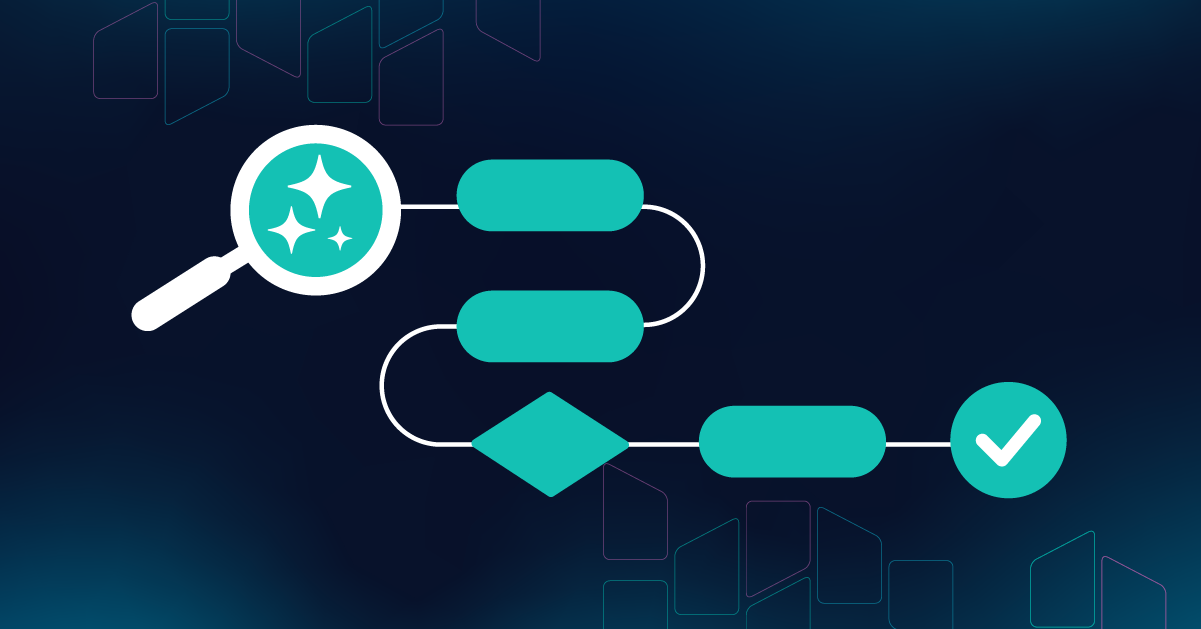
While there is no denying that traditional automation methods reduce manual effort (the benefits speak for themselves), AI takes contract workflow automation in CLM to the next level.
AI enhances speed, accuracy and decision-making in CLM by handling complex data-heavy tasks that previously contributed to the onslaught of bottlenecks. Its power lies in analyzing large volumes of structured and unstructured contract data to surface risks, drive consistency, and accelerate outcomes for both legal and the wider business. Let’s explore some of the most impactful ways AI is transforming contract workflows:
- Natural Language Processing (NLP) for clause identification: AI can interpret complex legal language, flag ambiguous or high-risk clauses, and suggest revisions aligned with your organization’s playbooks, speeding up reviews while improving consistency and risk control.
- Predictive analytics for risk scoring: By analyzing historical data and contract context, AI can assign risk scores to agreements or specific clauses, helping legal teams’ triage more effectively and focus their attention where it matters most.
- Auto-tagging and metadata extraction: Upon upload, AI can instantly extract key contract data such as renewal dates, jurisdiction or liability terms, making it easier to track obligations and avoid costly oversights.
- Smart routing and task automation: AI can route contracts and tasks based on context, workload and priority, improving throughput and ensuring the right person is working on the right task at the right time.
- AI-assisted negotiation and redlining: Integrations with tools such as BlackBoiler apply pre-approved guidelines to automate redlines for standard agreements like NDAs or supplier contracts, reducing legal bottlenecks and driving consistency at scale.
By automating low-risk, high-volume activities, AI enables legal teams to focus on more strategic high-impact work. It also reduces the risk of human error, ensures compliance with policy, and contributes to a more balanced and efficient workload across the team.
And when embedded within a unified legal workspace, AI doesn’t just improve individual tasks; it enhances the flow of work across the entire contract lifecycle.
Five ways to achieve contract workflow automation
Contract workflow automation isn’t just about speed; it’s about enabling structure, consistency and control across every stage of the contract lifecycle. Here are five practical ways to begin automating your contract workflows to unlock greater efficiency:
1. Centralized repository: build the foundation for automation
Automation starts with good data. A centralized contract repository provides a single source of truth, ensuring that contract data and metrics like key dates, clauses and metadata is organized, accessible and accurate. With everything stored in one unified legal workspace, you can easily trigger workflows based on specific contract terms, making automation more reliable and effective across the board.
2. Automated contract approval workflows: streamline compliance and speed
Manually routing contracts for approval can be time-consuming and inconsistent. Automating approval workflows based on predefined rules such as contract value, type, region or department ensures contracts reach the right stakeholders quickly and in the right order. This improves compliance with internal policies, reduces turnaround times, and removes the need for legal teams to micromanage every step. With mobile-friendly platforms, approvers can take action on the go, minimizing delays and keeping contracts moving.
3. Deadline, obligation, and compliance reminders: never miss a critical date
Missed deadlines and obligations can lead to costly renewals or compliance issues. Automating reminders for key dates like renewal windows, notice periods and performance obligations ensures nothing falls through the cracks. Even better, AI can extract these dates automatically during contract upload, so workflows are triggered without any manual input. It’s a simple way to reduce risk and maintain proactive contract management.
4. Contract templates: enable fast, consistent contract creation
Templates with guided forms make it easy to standardize contract creation, especially for high-volume, low-risk agreements like NDAs. Business users can self-serve by inputting essential information, generating contracts without needing legal review for every instance. This accelerates the contract creation process, reduces legal workload, and ensures consistency across similar agreements.
5. Integration with other systems: extend automation across the business
To maximize impact, legal automation should connect seamlessly with the rest of the business. Integrating your CLM with tools like Microsoft Power Automate, Salesforce, Slack or Teams enables intelligent cross-functional workflows. For example, intake forms can automatically route matters based on fields like priority or region, while contract status updates can trigger real-time notifications to sales or procurement. These integrations streamline communication, reduce back-and-forth, and bring legal into the broader business workflow.
Together, these five strategies help in-house legal teams move from reactive contract handling to proactive, scalable contract operations – with automation at the core.
Key considerations for contract workflow automation
Contract workflow automation in CLM holds enormous potential, but success depends on making smart strategic decisions up front. Before jumping in, legal teams should consider the broader tech ecosystem, the quality of their data, and the role people still need to play.
Here are five critical considerations to get right:
Automation should be part of a bigger picture
With a crowded legal tech market, it’s easy to fall into the trap of layering on isolated tools for automation. But true transformation happens when automation is embedded within an integrated end-to-end legal workspace. AI and automation should enhance (not replace) existing legal workflows like matter, contract and spend management. This holistic approach reduces system fragmentation, simplifies adoption, and enables more powerful insights by drawing from a broader dataset.
AI is a product feature, not a standalone product. When embedded within your CLM, AI doesn’t add complexity – it becomes a seamless part of how work gets done.
Clean data means reliable contract workflow automation
Automation is only as good as the data that powers it. Inaccurate, incomplete or inconsistent contract data leads to broken workflows and unreliable outcomes. Before implementing automation, legal teams must ensure their contract repository is structured, centralized and standardized. This foundational data hygiene enables workflows to trigger accurately and consistently, whether it’s routing approvals or sending compliance reminders.
Adoption is critical
Even the best-designed automation won’t deliver value if it’s not adopted. Legal professionals are understandably cautious when it comes to new tech, especially AI-driven tools. Embedding automation within tools teams already use lowers the barrier to entry, reduces the learning curve, and accelerates time to value. Ongoing training, stakeholder involvement and clear communication about benefits are all essential to a successful rollout.
Human oversight remains essential
While AI can enhance speed and consistency, it can also introduce risk if left unchecked. Legal nuance, client context and ethical considerations require human judgment. That’s why the most effective AI-powered CLM systems are built with human-in-the-loop capabilities, enabling legal teams to review outputs, apply discretion, and override automation when necessary. This safeguard ensures trust, compliance and high-quality outcomes.
Embed AI where your data lives
Standalone AI tools often require duplicate workflows, retraining, and siloed data. By contrast, embedding AI directly within your CLM and legal workspace allows it to tap into your proprietary data in a secure and context-aware way. This leads to more accurate clause suggestions, smarter routing, and better insights without exposing sensitive information or training generic models on your private data.
Contract workflow automation, together with AI, has the power to transform how legal teams manage contracts, but only when implemented with care, context and strategy. By focusing on integration, data quality, user adoption and ethical oversight, legal teams can future-proof their CLM and deliver meaningful long-term value to the business.
Quick recap: How to get started with contract workflow automation
While we’ve covered the benefits and best practices of contract workflow automations in detail, here’s a quick recap of how to move from insight to action:
- Focus on features that solve real problems Don’t get distracted by long feature lists. Instead, evaluate CLM platforms based on the specific challenges you’re trying to solve, whether that’s speeding up approvals, reducing contract risk or enabling self-service for business users. Look for tools with automation baked into its core functionality, not added on as an afterthought.
- Align your business case with stakeholder goals To secure stakeholder buy-in, frame your business case in business terms: faster deal velocity, reduced risk exposure, time saved for legal and the business, and improved visibility. Show how automation supports company-wide goals like digital transformation, revenue growth or operational efficiency.
- Prioritize strong implementation Success with contract workflow automation starts with a strategic implementation plan. That means involving the right teams early, ensuring your data is clean, and tailoring the platform to your internal processes. The best outcomes come from implementation partners who understand legal workflows and can help guide setup, integration and adoption.
Ready to transform your CLM with contract workflow automation?
Contract workflow automation, especially when enhanced with embedded AI isn’t just a tech upgrade. It’s a smarter, faster and more strategic way for legal teams to scale their impact, reduce risk, and unlock business value.
Whether you’re looking to eliminate manual bottlenecks, improve compliance or empower the business to self-serve on contracts, the right CLM platform makes all the difference.
Explore how LawVu helps legal teams simplify and automate contract workflows with AI built into a unified legal workspace. To see LawVu in action click here for your very own demo, or click here to learn more about CLM in a legal workspace.
